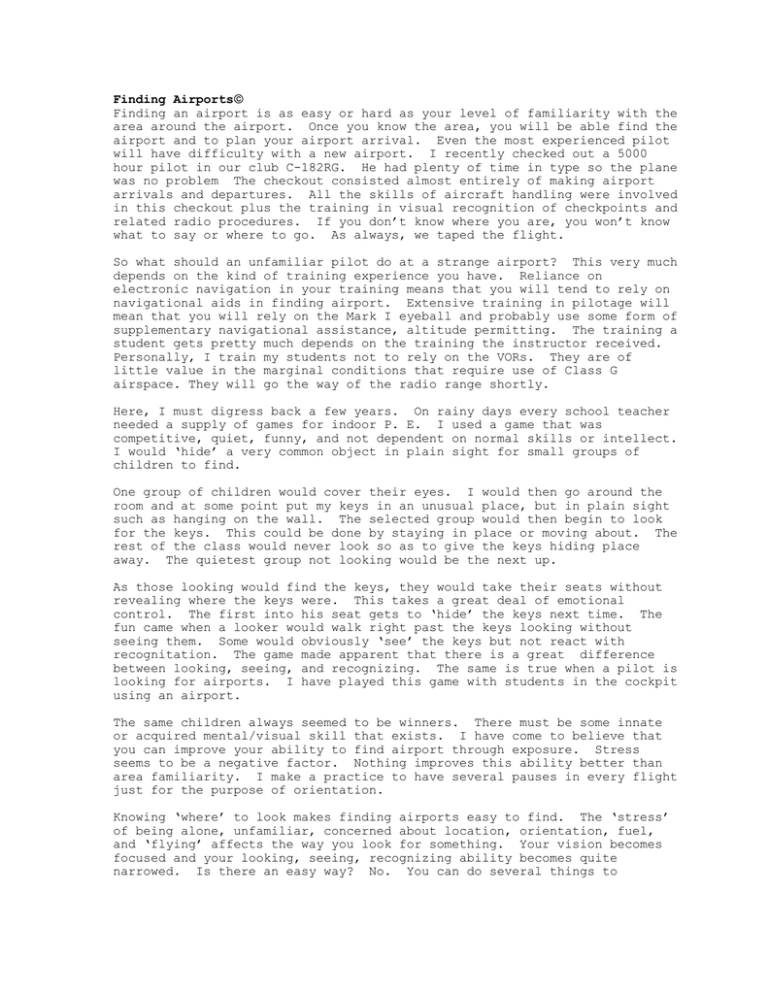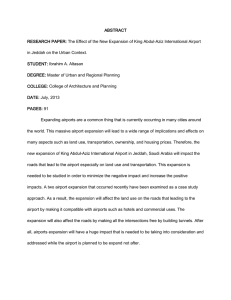Finding Airports
advertisement

Finding Airports Finding an airport is as easy or hard as your level of familiarity with the area around the airport. Once you know the area, you will be able find the airport and to plan your airport arrival. Even the most experienced pilot will have difficulty with a new airport. I recently checked out a 5000 hour pilot in our club C-182RG. He had plenty of time in type so the plane was no problem The checkout consisted almost entirely of making airport arrivals and departures. All the skills of aircraft handling were involved in this checkout plus the training in visual recognition of checkpoints and related radio procedures. If you don’t know where you are, you won’t know what to say or where to go. As always, we taped the flight. So what should an unfamiliar pilot do at a strange airport? This very much depends on the kind of training experience you have. Reliance on electronic navigation in your training means that you will tend to rely on navigational aids in finding airport. Extensive training in pilotage will mean that you will rely on the Mark I eyeball and probably use some form of supplementary navigational assistance, altitude permitting. The training a student gets pretty much depends on the training the instructor received. Personally, I train my students not to rely on the VORs. They are of little value in the marginal conditions that require use of Class G airspace. They will go the way of the radio range shortly. Here, I must digress back a few years. On rainy days every school teacher needed a supply of games for indoor P. E. I used a game that was competitive, quiet, funny, and not dependent on normal skills or intellect. I would ‘hide’ a very common object in plain sight for small groups of children to find. One group of children would cover their eyes. I would then go around the room and at some point put my keys in an unusual place, but in plain sight such as hanging on the wall. The selected group would then begin to look for the keys. This could be done by staying in place or moving about. The rest of the class would never look so as to give the keys hiding place away. The quietest group not looking would be the next up. As those looking would find the keys, they would take their seats without revealing where the keys were. This takes a great deal of emotional control. The first into his seat gets to ‘hide’ the keys next time. The fun came when a looker would walk right past the keys looking without seeing them. Some would obviously ‘see’ the keys but not react with recognitation. The game made apparent that there is a great difference between looking, seeing, and recognizing. The same is true when a pilot is looking for airports. I have played this game with students in the cockpit using an airport. The same children always seemed to be winners. There must be some innate or acquired mental/visual skill that exists. I have come to believe that you can improve your ability to find airport through exposure. Stress seems to be a negative factor. Nothing improves this ability better than area familiarity. I make a practice to have several pauses in every flight just for the purpose of orientation. Knowing ‘where’ to look makes finding airports easy to find. The ‘stress’ of being alone, unfamiliar, concerned about location, orientation, fuel, and ‘flying’ affects the way you look for something. Your vision becomes focused and your looking, seeing, recognizing ability becomes quite narrowed. Is there an easy way? No. You can do several things to help yourself. Fly higher, select a nearby high-visibility checkpoint for orientation purposes. Learn to look for trapezoids instead of rectangles. Here in California the time of the year makes a great difference. An airport is usually far move visible with a green background than a tan one. Most single runway airports parallel the prevailing winds. When it comes to selecting runway direction I suggest that you turn to fly in the runway direction. Then look in the presumed direction of the airport. By using the heading indicator you can, once the runway is spotted, set yourself up for any 45 degree entry arrival by aiming at the runway numbers and noting the runway number on the HI. In left traffic the runway number will be at the left rear 45 arrow of the HI; for right traffic the runway number will be at the right rear 45 arrow. Adjust your arrival path until you get the correct reading with allowance for wind drift. Stay well above pattern altitude until you really have the airport in sight. The most difficult runway alignment I remember facing was at St. Joseph, MO where three runways intersect near one end. I believe it was Sioux City where I called the ATC and asked if their tower resembled a silo. I received an affirmative only to find that the ‘tower’ I was really was a silo. I flew to Columbia, CA three times before I was able to find it at first crack. I finally chose a 15-mile checkpoint and flew a heading as the easiest way. Low and slow is not the way to look for an airport. I lost a new private pilot who spun in while trying to follow a car to a duster strip. With GPS there is little need for having difficulty any more. I have a generalization for night flight to airports. Try never to fly into an airport for the first time at night. Once flew into Kansas City Downtown at night in a rain storm. Even with radar help I did not see the runway until half-mile final. Twenty-mile visibility is not always a help if there are no distinctive checkpoints as in Kansas. The lower the visibility the more important it is that you know where you are in regards the airport location. I have found dusk conditions very difficult. The low fog layers that cover the S.F. Bay area at night will completely break up the usual patterns of cities and water so that electronic navigation is the only way to go.




